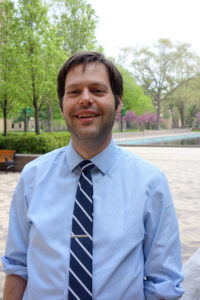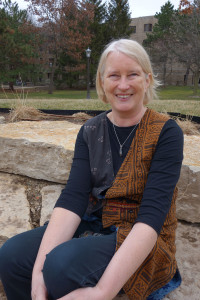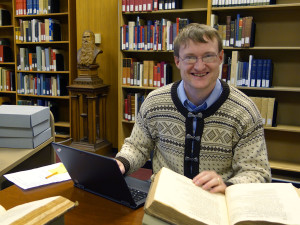Summer is always an exciting time for the department. This is when we take advantage of hiring students who have more time in their schedules to work on some of our larger projects and to assist with other departmental needs.
When RBSC hires students, our intent is not just to have them do work for us. We also introduce them to our world—manuscripts, rare books, maps, broadsides, prints, posters, ephemera—teaching them skills that often complement their studies and that, in some instances, provide the foundation for better understanding the materials they are using in their own research. Sometimes we are even delighted to hear that spending the summer working in RSBC inspired them to consider either doing research based on special collections or pursuing a career in our profession.
Our students’ work, though, often goes unnoticed because it is hidden in the processed collection, the online finding aid, the reorganized collections. To highlight our students’ efforts to make these materials accessible to students, faculty, and visiting researchers, we’d like to feature them in this week’s post.
Thomson Guster, MFA in Creative Writing
I assisted George Rugg with creating finding aids for two collections of letters. The first is for letters received by Jack Pfefer, a Russian emigre to the U.S. who, from the 1930s to the 1960s worked as “New York’s foremost wrestling impressario,” managing and promoting professional wrestlers. He helped transition wrestling from something regarded as a sport (like boxing) to the more theatrical entertainment it has become today. The second finding aid is for a collection of American Civil War letters written by two brothers from North Carolina, William Lafayette Barrier and Rufus A. Barrier, to their father, Mathias Barrier, while they served in the Confederate Army. William Lafayette served in the 1st North Carolina Cavalry and Rufus served in the 8th North Carolina Infantry. Only Rufus survived the war.
This summer gave me an appreciation for the laborious process of organizing and making available special collections like these—how all this hard work, done incrementally and by many people over many years, ends up producing a quality database that will, hopefully, be used by researchers to come.
Arnaud Zimmern, Ph.D. English
I worked with Julie Tanaka to process two collections; one of French manuscripts and printed documents related to funerary practices and laws, the other of telegrams from the Havas French Press. For both, I organized and described the materials in the collections and then drafted EADs for them.
When I started this summer, I had never worked on archival collections, so I had to learn the basics of organizing and describing a collection. After ten weeks or so, I learned quite a bit about thinking like an archivist and about inhumation practices in Napoleonic-era France.
Halfway through the summer’s work, I could already tell that few things get me as excited as making sense of old documents and seeing a story unfold from otherwise inert tree pulp. I guess that confirms to me that I am an aspirant researcher, although I know I still have long strides to make in terms of developing stamina (sitting for long hours is not my favorite) and in terms of sharpening my curiosity and intuitions. For one, I have yet to really build up the habit of taking nothing in a document for granted. But conversely, I now know experientially what it means to let primary sources enter into your imagination and breathe for themselves, tell their story. To illustrate what I mean, the turning point in my work this summer was when it finally struck me that the burial practices that Napoleon established in 1805-1806, of which I was holding some of the foundational documents, were effectively identical to those in place at my grandmother’s burial a year and a half ago in Paris. Research is me-search, as the saying goes, but I never expected archiving to be me-archiving.
Kelly Koerwer, Senior, Program of Liberal Studies and Medieval Studies
I worked on the Patrick McCabe papers. McCabe is a contemporary Irish author who is best known for his novels, The Butcher Boy and Breakfast on Pluto, both of which were made into films. Under the guidance of Aedin Clements, the Irish Librarian, I sorted through the many boxes of papers McCabe sent the University. Among others, there were drafts and fragments of plays, poems, short stories, novels, and screen plays of his many works, both published and unpublished, as well as financial information and business and personal correspondences.
My summer in RBSC has provided valuable insight into the world of archiving. I began interning in RBSC because I am writing my thesis on the relationship between archiving and the creation and destruction of memory. By working in an archive, I learned that just as human memory can be selective, so can an archive’s memory. It is the duty of the archivist to provide as complete a picture as possible with the materials available. I loved working in RBSC, and I know that because of this experience, I am better equipped to understand the art of archiving.
Eve Wolynes, Ph.D. History
I assisted Dave Gura with reorganizing the collection of rare book vendors’ sales catalogs. This collection provides important documentation about book sales such as prices, provenance, vendors, and when a copy of a particular book was last on the market. In many cases, the catalogs provide the only documentation of the locations rare manuscripts are held in private collections and that would otherwise be untraceable. I helped assess the collection. I then organized the remaining sales catalogs. In addition, I assisted Dave with copyediting the incipit indices (index of the beginning words or line of Latin texts) for his forthcoming descriptive catalog of medieval manuscripts held at Notre Dame and Saint Mary’s College.
The behind-the-scenes work was only a part of my summer in Special Collections. I also staffed the front desk where I was the first point of contact for visitors. I answered numerous questions about the department and its collections, registered researchers, and set them up to use materials in the reading room.
Nelia Martsinkiv, Ph.D. History
I worked with Ken Kinslow and Natasha Lyandres in Special Collections since November of 2015. This summer, I was able to continue some projects that I had started earlier. During the academic year I was able to work only for a couple of hours a week while this summer gave me the opportunity to concentrate on more comprehensive projects that will prove useful for my dissertation. In particular, I organized and described the papers of a notable Soviet dissident, Boris Tsukerman. These papers are of a great importance for scholars working within the field of human rights in modern Europe and Russia as they help to reveal the legalist dimension of the dissident movement at the time. Also I plan to work on the Tsukerman collection this fall, but this time for the purposes of my research paper. Outside of working on the Tsukerman Papers, I assisted with other minor projects. Specifically, I assisted in the cataloging efforts for the Natalia A. and Irina V. Roskina, the Eleonora P. Gomberg-Verzhbinskaia, and the Iiuliia Markovna Zhivova and Ivan Dmitrievich Rozhanskii papers.
Work at the Special Collections this summer gave me a broader perspective of what I can do after completing my dissertation. Specifically, sorting and cataloguing Tsukerman Papers revealed how some very important dissidents are understudied and therefore generally unknown in the academic world. This persuades me that outside of working with already catalogued collections, I have to pursue opportunities to acquire new and unsorted papers and make them known to scholars of human rights and political dissidence.
Elizabeth Kramer, Junior, Animation major, University of Saint Francis, Fort Wayne, IN
Elizabeth, home for the summer from the University of Saint Francis, in Fort Wayne, IN, worked with Sara Weber on a number of digital imaging projects. For a project that was begun during the school year, she finished organizing and foldering materials in a collection of baseball sheet music and locating records in WorldCat for the materials that had them. She entered this information into a Google doc so that this metadata could be imported when the digital collection is created in the fall, then scanned the pieces not in copyright. She also took digital photographs for other projects including the fall exhibit, Ingenious Exercises: Sports and the Printed Book in Early Modern Europe, 1500-1800, the forthcoming digital exhibits on basketball and the Durand collection, and also a project underway pertaining to a collection of medieval manuscript fragments.
When asked about her experience working Notre Dame’s Special Collections, Elizabeth had this to say:
I enjoyed being able to work hands on with the rare books. I especially enjoyed the more decorative books and the ones with an abundance of old illustrations and prints. Hopefully I can incorporate what I’ve seen and worked with into my future work.

 joined Rare Books and Special Collections in August 2010 as Curator of Ancient and Medieval Manuscripts. Trained in Greek and Latin with particular interests in textual criticism, Latin paleography, and manuscript studies, Dave earned his B.A., M.A., and Ph.D. from The Ohio State University. His doctoral research examined the transmission of the Roman poet Ovid in the Middle Ages and culminated in his dissertation, “A Critical Edition and Study of Arnulf of Orléans’s Philological Commentary to Ovid’s Metamorphoses,” under the supervision of Professor Frank T. Coulson.
joined Rare Books and Special Collections in August 2010 as Curator of Ancient and Medieval Manuscripts. Trained in Greek and Latin with particular interests in textual criticism, Latin paleography, and manuscript studies, Dave earned his B.A., M.A., and Ph.D. from The Ohio State University. His doctoral research examined the transmission of the Roman poet Ovid in the Middle Ages and culminated in his dissertation, “A Critical Edition and Study of Arnulf of Orléans’s Philological Commentary to Ovid’s Metamorphoses,” under the supervision of Professor Frank T. Coulson.
 With his excitement barely contained,
With his excitement barely contained, 
